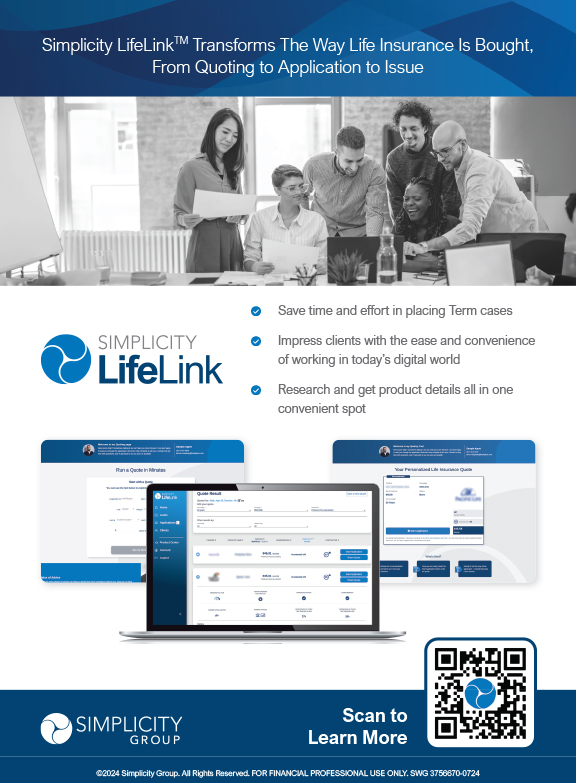Getting it right at the start
How to motivate life insurance buyers who are faced with higher costs than their healthier counterparts daunts many advisors. The question is anything but theoretical since nearly 50 percent of current cases are classified as impaired risk.
Life insurance sales is not for the faint of heart, particularly since many advisors find it difficult approaching prospects with “sensitive” health questions. It interferes with and can disrupt the sales process, making it both difficult and uncomfortable for advisor and client.
It need not be this way if advisors view their role as helping clients reach a goal or objective. By taking this approach, discussing personal issues such as health and medical history are put into perspective and become an essential part of the process.
Prudent advisors recognize that impaired risk is the new normal, not the exception, and they are well-prepared with the knowledge needed.
Further, they embrace the impaired risk process as one of shepherding clients so they come to view it as a partnership with the advisor. The client’s unique role is being candid and forthcoming about their health and medical situation because that’s what it will take for them to gain the coverage they need and want.
All of which is to say that an informed and actively engaged prospect is more likely to become a motivated life insurance buyer. Or, to put it another way, participation is persuasion.
The road map to success
Even so, beware! Like any road map, there are challenging twists and turns, blind spots, and unexpected surprises that are involved in writing and placing impaired risk cases. To keep them to a minimum, the sales process of getting a motivated client—or a client motivated, as the case may be—should begin with a realistic appraisal of what is possible for the client. Specifically, how various possibilities can assist clients reach their personal or business objectives.
During their discussion, advisor and client drill down and evaluate the options so the client understands each one and can make informed choices or select an agreed upon course of action. During this process it’s germane that the advisor addresses the underwriting component:
- The advisor needs to encourage clients to relate information pertaining to their personal medical history to assess the realities of any pricing that is discussed.
- Many clients may know the significant details related to their medical history. Others, however, may not be as aware or, worse yet, be in denial or deliberately obscure medical health challenges that could impact underwriting results. It’s not unusual to have what appears to be an “open discussion” to later discover that the client has been less than candid in disclosing medical or social impairments that will ultimately impact the client’s life underwriting.
- Throughout all such discussions, it needs to be made clear that underwriting is an essential part of the process for obtaining a client’s desired result.
Engaging a client
How to go about successfully engaging an impaired risk is critical and should be taken seriously because of the impact it can have on the outcome of the case. This is where the advisor’s primary role becomes that of a consultant rather than a salesperson, which a prospect may typically associate with some life insurance producers.
When client and advisor are on the same page, there is no confusion or distrust and expectations are easily managed.
The knowledge that’s needed for success
Granted, advisors should be able to raise probing questions to determine a case’s underwriting challenges. However, this is not always where advisors can find themselves. Since so many cases today involve impaired risk issues, advisors are best served by educating themselves on the actual impairments to help frame questions so they are non-threatening or cause clients to be less than forthcoming.
In the same way, obtaining a HIPPA authorization enables advisors to begin to build a file. More information leads to greater understanding and a better result.
Building client files is also a helpful tool and valuable resource for advisors with impaired risk cases, particularly when two forces are at work at the same time. First, clients are often coping with doubt and anxiety to one degree or another involving their medical situation. And, second, impaired risk cases take longer to process—not just a day or two or even a couple of weeks, but often much longer—and this adds to a client’s distress. With each passing day clients can become more anxious, wondering if something is going wrong.
Advisors can manage cases and stay on top of their progress through the client file. Armed with this information, the advisor is better equipped to reassure clients. Their understanding can go a long way in making the process smoother and may even help to substantially shorten time frames to a point where shopping for coverage can begin in earnest.
It’s also worth noting that past application results are not necessarily a “slam dunk” for the way a new, current application will be viewed by an underwriter. The risk presentation may be substantially different than before when results were not so good. This can occur since there are factors that can turn a prior declination to a good offer, such as new clinical information, improved test scores, a more liberal carrier position on certain risks, or simply a better presentation to a different insurance company.
Two impaired risk case histories
Against this background, actual case histories can help put motivating impaired risk clients in perspective. Here are two cases:
The Case of the Cooperative Client
The client, a single, 43-year-old, highly-driven business owner, whose construction company was experiencing massive growth, was seeking an accumulation plan so he could contribute $200,000 annually for 10 years. The coverage would be $5 to $10 million. His father, who was his life insurance advisor, had tried three insurance companies to no avail before coming to us.
The father made it clear that his son’s medical history involved several accidents requiring back surgery that left him with severe back pain. His openness set the stage for a cooperative working relationship.
We began building a client file with the initial information. Although the client had seen a physiatrist regarding his persistent pain, he offered little help. Eventually, a “pain doctor” surfaced who was willing to assist in responding to carrier requirements for making a good offer. We then spoke with underwriters at several insurance companies to understand what would work.
Armed with the relevant talking points, the advisor/father then wrote a thoughtful and detailed letter as to why his son should be considered in a positive light. He pointed out his son’s unique personal attributes, while acknowledging that the son was on a medication that insurance companies reject since it’s commonly used to control the abuse of opioids.
We then selected three insurance carriers that said they could give an offer based on our discussions and a written summary of the case. One approved at a Table D, another at Table B, and a third at a Standard non-smoker rate, which the client accepted, and then added $10 million of term life for bonding purposes and future corporate needs.
The Case of the Controlling Client
This case involved a pressuring and overbearing client who was less than forthcoming when seeking $25 million of life insurance coverage for his personal needs.
A 57-year-old male, he gave us the name of his primary care physician and we obtained his medical history, which raised a number of questions related to various medical issues. In addition, it referenced regular psychiatric visits. However, the name of the psychiatrist was missing. While this raised concerns, the client passed it off as “dealing with anxiety related to his divorce.”
As it turned out, the insurance summary was getting mixed results from the 20 carriers we were shopping. The concerns amounted to a variety of medical issues including the missing psychiatric counseling history and notes. We saw offers ranging from Preferred (two carriers), a Standard, and four Table D offers with the rest as declinations.
Of the two tentative Preferred offers, one carrier didn’t indicate a need for a psychiatrist’s statement. A formal application was submitted, which permitted the carrier to request a report from the prescription database. It revealed a detailed record of prescriptions filled, along with dosages, dates and name and address of the referring psychiatrist.
As a result, we now had the information the client had not made available to us. It was clear from the name and nature of the medication prescribed that this would never be a Preferred case and probably not Standard. Even so, we now knew where to get the missing piece of the case to build a complete file. We would write to the psychiatrist to make available his office notes for this patient.
Armed with the knowledge of the doctor’s name and the prescription ordered for his patient, we would be able to confront the prospective client. Originally, we were all too ready to accept the prospect’s version of his psychiatric history. He now owned up to having seen this psychiatrist, but expanded on what seemed obvious. He had only seen this psychiatrist twice and did not complete or refill the regimen of medication ordered for his diagnosis. That history was two years prior and followed by another medical professional that the client made known to us. This professional did not diagnose the patient with the same impairment, thus reducing the seriousness of the previous diagnosis.
During our shopping process, we discovered that the prospect had made applications a year before, only to receive declinations from those carriers. That finding was understandable and less of a concern now that we were armed with all of the facts needed to present the case.
Our request for file notes and history generated a one-page handwritten note jam packed with pertinent historical information. The letter revealed a long history of failed trials and a few serious psychological concerns on the part of the doctor. The client then ended his relationship with the psychiatrist and began seeing a psychologist who viewed him in a much better light.
The two companies that were potentially offering preferred backed off their tentative offers and changed them to Table C, given the psychiatrist’s report. A third company offering Standard non-smoker, withdrew and was now a “decline to offer.”
A fourth company expressed interest in competing for the case and made a generous offer of Standard non-smoker. They made that offer based on their analysis that the client was off all medications for two years, was functioning quite well, and had a good report from the most recent attending mental health professional. It can be a magical feeling when you get an offer that works for the case after having so many twists and turns.
When informed, the client was very pleased and there was a positive exchange. The client now seemed transformed into a different person. In fact, he was so happy, he issued a check for the $365,000 premium.
Yet, the question remained: Since it would have saved everyone a considerable amount of time, why was the client not forthcoming until confronted with the reality of his situation? We surmised that his need for privacy wouldn’t permit him to open up until he was pressed and his history became known. Once he was found out, he became a much friendlier, happier, and free person, who was prepared and willing to write a check for a substantial insurance premium.
Whether impaired risk clients are cooperative or difficult makes little difference. What’s important is how the advisor manages a case. Here are some thoughts about that:
- Dismiss any preconceived ideas about the case.
- Be relentless in tracking down every possible bit of information. Be open with insurance underwriters to gain their trust.
- Keep looking for what may be missing that will be the key to unlock the case.
- Be willing to confront a client with gaps, missing pieces, and erroneous information.
- Let your actions make it clear that you don’t give up. This will do more than anything to motivate a client.
- If you’re successful at working in the impaired risk space, it won’t take long before you earn a reputation as the go-to advisor for these cases.






































Low Interest Rates: The New Normal
Yield Compression
It’s not breaking news that life insurance carriers (and everybody else) have seen 37 years of dropping yields on bonds. At the time of this writing, the Moody’s Baa Corporate Bond Yield sits right at 3.91 percent, which is more than 100 basis points lower than at the beginning of the year! I believe that the Baa yield is the best proxy for insurance company investments because insurance carriers predominantly invest in investment grade corporate bonds versus treasury bonds. After all, if you can buy a bond from a strong investment grade company that yields 50—150 basis points over a treasury bond, why wouldn’t you? Furthermore, carriers generally invest more prominently in Baa type bonds than Aaa type bonds.
Because of these persistent low interest rates, insurance carriers have been forced to reprice their annuity and life insurance products many times over. This is because of the resulting decreases in general account yields. To put numbers to it: At the end of 2007 the aggregate yield that U.S. life insurance companies were getting on their fixed income assets – which is usually what backs life and annuity products – was 6.1 percent. Well, based off the 2018 ACLI Life Insurers Fact Book, that yield in 2017 (10 years later) had dropped to 4.43 percent. Thus, it is no mystery why caps on IUL have decreased. Furthermore, I don’t believe the pain is over yet for two primary reasons.
By the way, the federal reserve does not control long-term rates with the fed funds rate! The federal funds rate only controls the short end of the yield curve. Market forces control the 10-year, 20-year, 30-year treasuries, etc. Now, the federal reserve could (and has) affect the long end of the yield curve by their quantitative easing or tightening, but that is different than the federal funds rate.
Yield Compression=Lower Caps, Higher Term/GUL Rates, Lower Dividends
For the fun of it, let’s do some IUL pricing based off the 2007 general account yield of 6.1 percent and compare that to today.
Let’s assume our General Account is yielding the 6.1 percent. As we discussed previously, this was the case in 2007.
Let’s also assume we are pricing a cap on an annual reset S&P 500 strategy within an IUL. Assuming a $10,000 net premium going into the IUL, how much money would need to be invested in those general account bonds so the $10,000 grows back to the original $10,000, based off the yield of 6.1 percent? The answer is $9,425. In other words, when the $9,425 grows by 6.1 percent over the next year, the insurance company will have the client’s premium back which is the goal! This means we have $575 ($10,000 minus $9,425) as an options budget. What does the insurance company do with that $575?
Not to get too technical but the company buys a S&P 500 call option “at the money” and sells an S&P 500 call option “out of the money.” The difference between what the carrier bought the option for and sold the other one for should equal $575. Based off today’s options prices, an “at the money call” would cost the carrier $747—which is more than our option budget. Too bad because if we had enough option budget for this call, we would have an IUL with unlimited upside, i.e. no cap. So, instead, we will buy that option and sell another one so we net-out to our $575 budget.
In order to capture our $172 ($747 minus $575), we need to sell a call for “out of the money” by about 11.5 percent (based on today’s prices). What we have just done is given the upside beyond 11.5 percent to somebody else! Voila! If it were 2007, our IUL product would have a cap of 11.5 percent.
What about today? It’s a big difference. Based on the math that uses 4.43 percent as a general account yield, we would only have a cap of 7.5 percent!
Now, you may be thinking, “But many IUL products are currently offering caps much higher than 7.5 percent!” You are right and this concern is addressed in a couple of my points below.
What are my points?
Point 1: The pressure that insurance carriers are feeling is real! Insurance companies are faced with a 37-year dropping interest rate environment and as a result they have been forced to adjust the pricing on policies as well as discontinue products. Not because they wanted to, but because they have had to.
Point 2. It is paramount that an agent is working with a carrier that knows what they are doing and how to hedge these products.
Point 3: If you are an agent, do your due diligence and partner with an IMO that knows how these products work and knows the carriers involved! These products are technical and therefore you should partner with technical people! Ask your IMO to “stress test” various products.
Point 4: Know that there are ways that a carrier can subsidize the option budgets with internal charges to give the product more upside than a 7.5 percent cap. Of course, additional expenses do come with additional risk. Thus, the importance of the “stress test.”
Point 5: If internal charges in the policy are extremely low and caps seem too good to be true, ask questions!
Point 6: Although I used IUL as an example above, know that dropping general account yields are not just an IUL problem, this is a term problem (increasing prices), this is a GUL problem (increasing prices), this is a whole life problem (decreasing dividends), etc.
Point 7: Good carriers will separate themselves from the bad over the coming years in how they treat the consumers with the caps, rates, dividends, etc.
Point 8: Don’t just disclose to the clients that caps can decrease on their policy. Set the expectation that they will! Underpromise and overdeliver.
Point 9: Needless to say, be prudent with illustration assumptions.
The silver lining:
The silver lining is that there will eventually be a point of “equilibrium” where the general accounts no longer yield more than the new investments put into the general account. I am hoping we are close to that point as the Moody’s Baa yield is not too much lower than the average general account yield. In the end, the value of all these products is relative to what else is out there and the value is still unquestionable. After all, prevailing interest rates have also dropped the rates of savings accounts, certificates of deposit, money market accounts, etc.
In Closing
The magic that these products provide, whether life insurance or annuities, lies in the mortality and longevity credits. With life insurance, if one dies prematurely there are thousands of other insureds in the insurance pool that pay for the death benefit of the deceased that could equal multiples of the premium the insured paid. Ben Feldman would discuss that with life insurance you can purchase “dollars with pennies.” With annuities you have the inverse: If you live until the ripe old age of 110, those in the “pool” that passed away early bought the “longevity credits” that guarantee you lifetime income. Mortality and longevity credits are what make these products special. By the way, the potential tax benefits of life insurance and annuities are kind of nice as well!